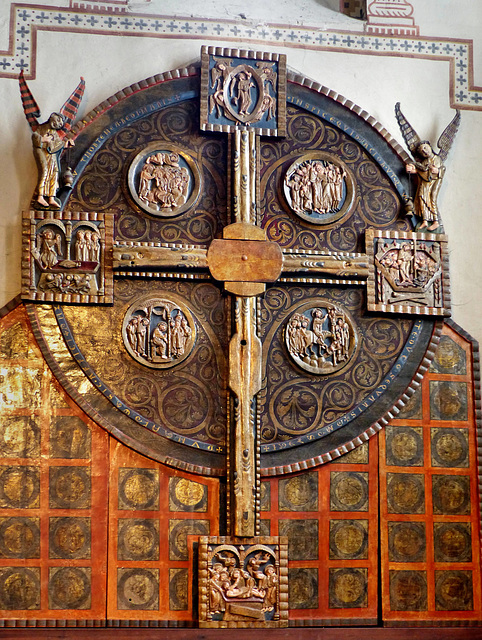Regen und Sonne (2 x PiP)
Palermo - San Giovanni degli Eremiti
Lund Cathedral (Lunds domkyrka), Sweden > The figu…
Lund Cathedral (Lunds domkyrka), Sweden
Lund Cathedral (Lunds domkyrka), Sweden
Lund Cathedral (Lunds domkyrka), Sweden
Lund Cathedral (Lunds domkyrka), Sweden
Lund Cathedral (Lunds domkyrka), Sweden
Lund Cathedral (Lunds domkyrka), Sweden
Lund Cathedral (Lunds domkyrka), Sweden
Lund Cathedral (Lunds domkyrka), Sweden
Albugnano - Abbazia di Vezzolano
Albugnano - Abbazia di Vezzolano
La crypte de Dracula . Je me suis Carpaté , plutôt…
Ventimiglia - Cattedrale di Santa Maria Assunta
Ventimiglia - Cattedrale di Santa Maria Assunta
Ventimiglia - Cattedrale di Santa Maria Assunta
St. Michaelis
Church - Portal after first modifications - 767 CE
Saint-Julien-Chapteuil - Saint-Julien
Laval-sur-Doulon - Notre-Dame-de-l'Assomption
Església Nostra Senyora de les Grades, Marcèvol
Esglesia Parroquial de Santa Cecilia, Molló
Romanic Foro Ruins (HFF)
Soest - Hohnekirche (PiP)
Oestinghausen - St. Stephanus
Oestinghausen - St. Stephanus
bellíssim Romanic a Beget
Pomposa - - Fussboden-Mosaik
Pomposa
Saint-Florent - Cathédrale de Nebbio
Canari - Santa Maria Assunta
Lucciana - Santa-Maria-Assunta
Lucciana - Santa-Maria-Assunta
Valle de Rostino - Santa Maria di Riscamone
Vomécourt-sur-Madon - Saint-Martin
Lamballe - Collégiale Notre-Dame
Coimbra - Machado de Castro National Museum
Hoinkhausen - St. Pankratius
Kloster Knechtsteden
Le Monastier-sur-Gazeille - Saint Chaffre
Vouthon - Saint-Martin
Rivières - Saint-Cybard
Marillac-le-Franc - Saint-Didier
Brie-sous-Matha – Saint-Pierre
Location
Lat, Lng:
Lat, Lng:
You can copy the above to your favourite mapping app.
Address: unknown
Lat, Lng:
You can copy the above to your favourite mapping app.
Address: unknown
See also...
Keywords
Authorizations, license
-
Visible by: Everyone -
All rights reserved
-
284 visits
Soest - Hohnekirche


With a population of about 10.000 Soest was the most important town in Westphalia within the 11th and 12th century.
The "Soester Stadtrecht" ("Soest city law") is the oldest city law, documented in German territory. Soest was one of the most important Hanseatic cities in medieval times. During the "Soester Fehde" ("Soest Feud") it liberated itself from the Bishop of Cologne, who controlled Westphalia.
During and after the Thirty Years' War, Soest suffered a tremendous loss population and influence. At the lowest point in 1756, it had only 3,600 citizens.
Soest has still a couple of wonderful medieval, Romanesque churches, built with the regional greenish sandstone. The "Hohnekirche" (officially "St. Maria zur Höhe") is one of them. The church was built in its present form from 1180 and is one of the oldest hall churches in Westphalia. It replaced an older church here.
This giant triumph-cross is a very unique piece of art here. This "Scheibenkreuz" ("plate cross"), created ~1200, is the only one in "mainland" Europe and the oldest. Something similar can be found almost only on the island of Gotland in Sweden. However, these crosses are younger.
Here nail marks exist, so originally Christ body was nailed to the cross. The plate cross, made of spruce and pine, has a height of 3.89 m and diameter of 2.72 m.
Soest has had a very strong position within the Hanse League so there were for sure ties to Northern Europe, where this cross may have been created. A recent renovation prooved, that the wood originated in Northern Europe.
A closer look.
The "Soester Stadtrecht" ("Soest city law") is the oldest city law, documented in German territory. Soest was one of the most important Hanseatic cities in medieval times. During the "Soester Fehde" ("Soest Feud") it liberated itself from the Bishop of Cologne, who controlled Westphalia.
During and after the Thirty Years' War, Soest suffered a tremendous loss population and influence. At the lowest point in 1756, it had only 3,600 citizens.
Soest has still a couple of wonderful medieval, Romanesque churches, built with the regional greenish sandstone. The "Hohnekirche" (officially "St. Maria zur Höhe") is one of them. The church was built in its present form from 1180 and is one of the oldest hall churches in Westphalia. It replaced an older church here.
This giant triumph-cross is a very unique piece of art here. This "Scheibenkreuz" ("plate cross"), created ~1200, is the only one in "mainland" Europe and the oldest. Something similar can be found almost only on the island of Gotland in Sweden. However, these crosses are younger.
Here nail marks exist, so originally Christ body was nailed to the cross. The plate cross, made of spruce and pine, has a height of 3.89 m and diameter of 2.72 m.
Soest has had a very strong position within the Hanse League so there were for sure ties to Northern Europe, where this cross may have been created. A recent renovation prooved, that the wood originated in Northern Europe.
A closer look.
- Keyboard shortcuts:
Jump to top
RSS feed- Latest comments - Subscribe to the comment feeds of this photo
- ipernity © 2007-2024
- Help & Contact
|
Club news
|
About ipernity
|
History |
ipernity Club & Prices |
Guide of good conduct
Donate | Group guidelines | Privacy policy | Terms of use | Statutes | In memoria -
Facebook
Twitter

Thank you for the info.
Sign-in to write a comment.